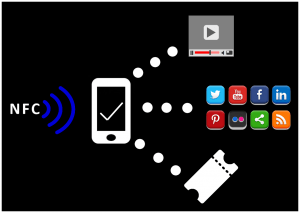As technology has ‘evolved’ so has its demand from its users and the need for quicker access / processing of information has exponentially grown. Imagine how many processes a human brain comprehends on a daily basis with data received via sensory gathering, essentially this is similar to how NFC operates. Data is transferred wirelessly and processed via the device and an output created and as a technology has yet to make a wide spread mark in the marketplace.
NFC operates by transmitting a signal from the reader to a bundled set of data containers (coil) this ‘coil’ retains minimal input data strings, which are bounced back, read, then decoded to output a desired action. This idea is nothing new building off the ideas found in older technology material such as QR readers and barcode scanners; however, NFC tags contain information i.e. not tied to an online service or requirement of an optical reader. At this year’s CES, we saw a variety of new NFC featured devices including NFC printers, home sensors and even more mobile and PC devices with NFC as standard. The technology is new and yet to hit its mark in a wider commercial sense but as my first set of tutorials will explain its uses in gaming, marketing and ease of access showing it as a technology we all should adopt and soon.
CES 2014 NFC Lineup
This year’s CES was NFC heavy with this year even being the first one to feature NFC badges as a method of entry and security provided by NXT. Below are SOME of the NFC devices revealed this year:
- LG NFC enabled TV’s
- NFC enabled printers
- NFC home sensors
- Rumour – New iPhones to feature NFC Chips
NFC and Trans-media – Brief exploration
Believe it or not but NFC is already making its mark and way into the media market on a growing scale with even NFC enabled business cards now being adopted by business professionals. So why is NFC good for marketing and media? Well, it is a actually believe it or not a cheap method of sending digital information quickly without an extensive understanding of technology or programming. Take for example NFC business cards people can scan these and instantly add contact information to their mobile device instantly without having to input loads of data and this is just the start. Websites, settings and even media can be controlled and sent between NFC devices and tags in a matter of seconds.
Imagine walking down the street and seeing a poster for a film that looks interesting, imagine using your phone to scan its NFC tag and instantly being able to watch the films trailer find out more information and even being able to book tickets all from just ‘tapping’ a poster. This form of marketing means otherwise none digital media forms can allow for digital links / transfer.
Companies such as Conducttr are already exploring its potential and easily allow users to create interactive real time campaigns allowing such technology to act as an intermediary. Robert Pratten CEO of Conducttr in this video below shows us some of the ways NFC and tools such as Conducttr can change the digital landscape.
We will explore NFC and Conducttr in more detail in future outings so stay tuned.




 Written by and Moderated by Stephen Fisher 2014
Written by and Moderated by Stephen Fisher 2014
Comments are closed.